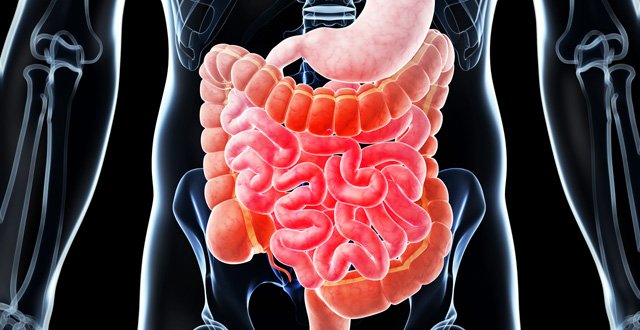Therapeutic drug monitoring is increasingly being used in the medical management of IBD, as it has many benefits but challenges remain
Inflammatory bowel disease (IBD) consists of two chronic life-long conditions resulting in inflammation of the gastrointestinal tract – ulcerative colitis (UC) and Crohn’s disease (CD). The severity and extent of the disease influences the choice of therapy that is used. Medical therapy for IBD is complex, as disease aetiology is compromised by the interaction of genetic, environmental, microbial and immune factors.
The aim of treatment of IBD is to achieve clinical remission (the absence of symptoms) and mucosal/intestinal healing (reducing the likelihood of digestive damage). The recent STRIDE consensus programme provides a useful framework.
For UC, remission is defined as absence of diarrhoea and rectal bleeding, and normal mucosa on endoscopy. For CD, the optimal target of treatment is the absence of diarrhoea and abdominal pain with evidence of healing at colonoscopy or on imaging studies.
In order to achieve these therapeutic goals, biologic therapies are often needed. These have revolutionised the treatment of IBD in the last two decades, and are now widely used in disease management. Biologics are recommended for patients who have moderately to severely active disease who have not responded to, or cannot tolerate, conventional therapies such as corticosteroids and/or immunomodulators. Biologic therapies currently approved include anti-TNFs (infliximab, adalimumab, golimumab), integrin receptor antagonists (vedolizumab), and Il-12 and IL-23 antagonists (ustekinumab) (see Table 1).
One of the challenges of using therapeutic antibodies as biologic medicines is the high variability in pharmacodynamics and pharmacokinetics. Peak drug concentrations, half life and trough levels of these medications can vary considerably between patients.
Clinical trials have consistently shown that in patients who maintain higher trough drug levels in serum are more likely to respond to the therapy. These differences are due to a range of factors such as disease activity/inflammatory burden, patient phenotype (particularly gender, body mass index) differences in drug clearance, drug immunogenicity and specifically the action of anti-drug antibodies (ADAs). In order to optimise therapy for patients, and align with treat-to-target paradigms, the role for therapeutic drug monitoring (TDM) has garnered more and more interest in recent times.
We review current knowledge on TDM, the benefits and pitfalls of measuring serum levels of therapeutic antibodies, and what the future may hold for TDM in IBD.
Therapeutic drug monitoring
The goal of TDM is to individualise drug dosing and regimen to achieve a targeted therapeutic range and desired efficacy. TDM can be used in a pro-active or re-active fashion. Proactive testing is used for routine testing of drug trough levels and ADAs when a patient is in remission. Reactive TDM refers to when the patient is having symptoms related to IBD that are confirmed with biochemical, radiographic or endoscopic markers of inflammation.
Loss of response (LOR) to medications is not uncommon. For anti-TNF medications LOR is thought to be around 33 per cent (CI 29-38) at one-year follow-up, but cumulative LOR has been as high as 71 per cent in some studies. Patients can lose response, or fail to respond to a biologic agent, for three main reasons:
Mechanistic failure. This is where the patient fails to respond despite optimal drug concentrations, and no detectable ADAs, in which case it is likely that the patient would not respond to a drug in the same class. The driver of disease is likely mediated by a different inflammatory process or immune mechanism not targeted by the drug in use.
Non-immune related pharmacokinetic failure. This is where a patient fails to respond in the setting of sub-therapeutic trough concentrations and an absence of ADAs. The patient is likely to respond to an escalation of dose or regimen.
Immune-mediated pharmacokinetic failure. This is where ADA development has been triggered against the biologic’s molecules and the patient exhibits high ADA levels and low trough concentrations. Dose escalation is less likely to work in this case, and changing the drug should be considered.
When using TDM, it is also important to understand the assay that is being used to measure the trough concentration and antibody levels. There are many commercial assays available for use, including drug-sensitive and drug-tolerant assays, and the type of assay can have a major influence on the results. Drug concentrations and detection of antibodies have a considerable inter-assay variability. The American Gastroenterology Association (AGA) recommends using the same assay to improve specificity, accuracy and reproducibility between results.
Reactive vs proactive TDM
Currently reactive TDM is recommended by the American Gastroenterological Association (AGA) and European Crohn’s and Colitis Organisation (ECCO) guidelines to help guide treatment changes. The evidence to support either proactive or reactive TDM is weak, and at high risk of biases. On combining the results from two of the studies, TDM was applied retrospectively and demonstrated that 82 per cent of patients with a sub-therapeutic trough level and no detectable antibodies, would have responded to dose escalation (RR, 1.71; 95 per cent CI, 1.39-2.11), while only 8 per cent with low or undetectable trough in the presence of ADAs would have responded (RR, 0.26; 95 per cent CI, 0.08-0.86). The quality of evidence, however, is low.
There are no studies on long-term outcomes of either strategy. Papamichael et al looked at the benefits of proactive TDM with infliximab in IBD. Their study found that patients in the proactive TDM group had reduced risk of treatment failure (HR 0.30 [95 per cent CI, 0.11-0.80]), IBD-related hospitalisations (HR 0.16 [95 per cent CI, 0.07-0.33]), and serious infusion reactions (HR 0.17 [95 per cent CI 0.04-0.78]), compared to the reactive TDM group. This study has received a lot of criticism due to design flaws and the considerable differences between patient characteristics in the two groups. Patients receiving pro-active TDM are by definition in clinical remission, and those receiving reactive TDM are symptomatic with evidence of inflammation. Patients with active disease are more likely to develop IBD-related morbidity and treatment failures, than those in remission.
Anti-drug-antibodies and immunogenicity
Because biologics are made of up of complex proteins derived partly or fully from animal or human biological sources, they are immunogenic and can trigger the formation of ADAs. This can lead to loss of response to treatment over time. The detection of ADAs is influenced by the type of biologic agent and the assay in use (drug sensitive vs drug tolerant assays) (see Figure 2).
All the biologic agents for which commercial assays are available demonstrate ADA development. Some agents are more immunogenic than others. For example, infliximab ranged from 0.0-65.3 per cent, as per Figure 2. ADA production among IBD patients compared to adalimumab where ADA development ranged from 0.3-38 per cent.
The ADAs have the potential to neutralise the effects of the biologic molecule, increase drug clearance, and reduce the amount of the drug reaching its binding site. This leads to immune-mediated pharmacokinetic treatment failure. In turn, it can lead to increased risk of infusion reactions and adverse events, and lead to an unmet treatment need for patients.
When ADAs are indeed detected, it is unclear what titre level is clinically meaningful. In addition, low titre ADAs may be transient and not be sustained. Transient ADA formation to infliximab was observed in 33-58 per cent of patients with low antibody titres. Physicians risk inappropriately adjusting patients’ dose or regimen based on transient titres. On the other hand, high titre ADAs and undetectable trough concentrations are generally persistent and neutralising. Unfortunately, there is no current data available to identify an optimal ADA titre cut-off.
There are multiple commercially available assays and a wide inter-assay variability in detecting ADAs; further confounding the results. In a cohort of patients that are generally monitored longitudinally, a reliable and reproducible assay would be vital in their medical management. Moreover, there is an emergence of drug-tolerant assays being developed, which differ from the drug-sensitive assays that were previously widely in use.
Drug-tolerant vs drug sensitive assays
A drug-sensitive assay (double-antigen bridging ELISA) is incapable of detecting antibodies in the presence of the drug itself. In the landmark TAXIT trial (Trough Concentration Adapted Infliximab) only 12/263 (4.3 per cent) of patients had detectible antibodies at screening. In recent times drug-tolerant ELISA assays have been developed, capable of overcoming drug interference and allowing the measurement of antibodies in the presence of the drug itself. Van Stappen et al re-analysed serum samples from a subset of patients in the TAXIT trial using a drug-tolerant assay. This increased the ADA detection rate from 21 per cent to 63 per cent at screening (p <0.0001). All patients who were ADA-positive with the drug-sensitive assay, were also ADA-positive with the drug-tolerant assay. Those patients with ADA titres in the highest quartile range also required higher cumulative doses to achieve optimal trough concentrations. Once the dose was optimised all patients had an equal chance of maintaining remission at one year.
The presence of ADAs is associated with accelerated drug clearance and loss of response, but drug-tolerant assays run the risk of over-detecting clinically irrelevant ADAs and incorrectly informing clinical decision making.
Drug trough concentrations
Target trough concentrations vary between the different biologic agents. Many studies have shown that sub-optimal trough levels are associated with an increased risk of secondary loss of response. The optimal trough level has not yet been established for all biologic agents currently available in the management of IBD. From the evidence available suggested serum trough levels are shown in Figure 3. Newer biologic agents do not yet have a validated targeted trough level, and although commercial assays may be available, interpretation of the results should be made with caution.
There needs to be a definable relationship between drug concentrations and therapeutic effect. The TAXIT trial was pivotal in demonstrating that TDM and individualised dose escalation had higher remission rates than empiric dose escalation. The AGA recommends a target trough concentration of ≥5µg/mL for infliximab and ≥7.5µg/mL for adalimumab to guide whether escalation of therapy is likely to be beneficial to the patient. It does not make any recommendations for trough concentrations for other biologic agents due to the paucity of information.
From the literature some suggested target trough concentrations have been identified (Figure 3). Further prospectively randomised trials are needed to carefully select the target value and adequately validate the results, with clinical correlation.
In reactive TDM (symptomatic patients), if the trough is below the target level, escalation of therapy should be considered and if it is above this level, switching therapy should be considered. Due to pharmacokinetic and pharmacodynamic variations between patients, and inter-assay variability, a single drug concentration may be too low to be effective for the individualised patient or unnecessarily high for treat-to-target end points.
It is also unclear if there should be different target ranges for CD or UC. Most studies in TDM in IBD have been for infliximab and adalimumab, and there are fewer studies on newer biologic therapies available. Trough concentrations should be interpreted with caution as to avoid unnecessary changes to patients’ dosing regimens.
Cost-effectiveness of TDM
Van der Valk et al showed in the COIN study that healthcare costs in IBD management were now mainly driven by the cost of medications due to the increased use of biologics. TDM can help escalate therapy and prevent secondary loss of response, and therefore reduce IBD morbidity, or can help discontinue an ineffective treatment strategy early.
There have been several studies that have shown reactive TDM results in cost savings compared to empiric dose escalation, and allows earlier implementation of an effective treatment. Estimated incremental cost-effectiveness gain over the empiric strategy ranges from $500,000 to $5 million per quality-adjusted life-year gain.
Proactive TDM, the more expensive drug tolerant drug assays, misinterpretation of the results and inappropriate changes to medications, can all easily add to increased cost without being translated to therapeutic efficacy for the patient.
Overall, the evidence would suggest that an appropriate TDM strategy would lead to major cost-savings in the use of complex bio-pharmaceuticals in IBD.
The future of TDM
TDM has significantly increased in use in the medical management of IBD. It has been shown to be beneficial in optimising drug efficacy compared to empirical dose escalation but major challenges still exist in the implementation and interpretation of TDM.
Target trough levels have yet to be established and validated for all available biologics to guide treat-to-target strategies in both UC and CD. With this knowledge biologic therapies can be targeted for individuals to improve treatment efficacy and outcomes. A consistent, reliable and interpretable drug-assay needs to be used to ensure accurate longitudinal follow-up of patients. As the assays improve in detecting ADAs, there needs to be careful interpretation of results.
This remains difficult due to the transient rise and fall of antibodies, and a lack of an established clinically significant titre level to guide medical management. Overall, TDM has benefits for guiding medical management of IBD and is more cost-effective than empiric dose escalation.
Further prospective trials are needed to advance our knowledge of TDM, particularly the application of proactive TDM, to improve treatment efficacy for IBD patients.
References on request













Leave a Reply
You must be logged in to post a comment.